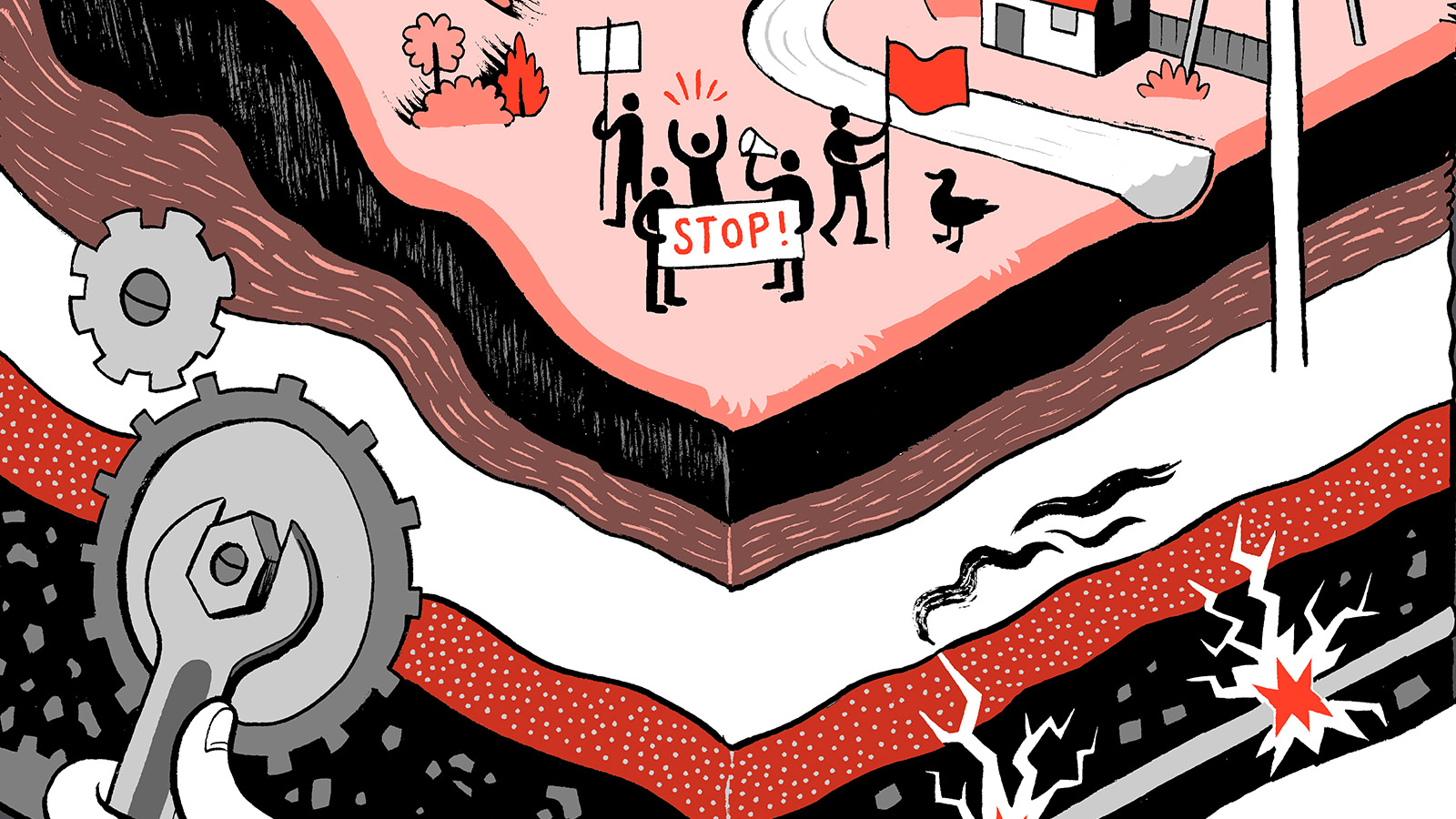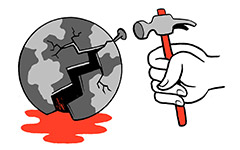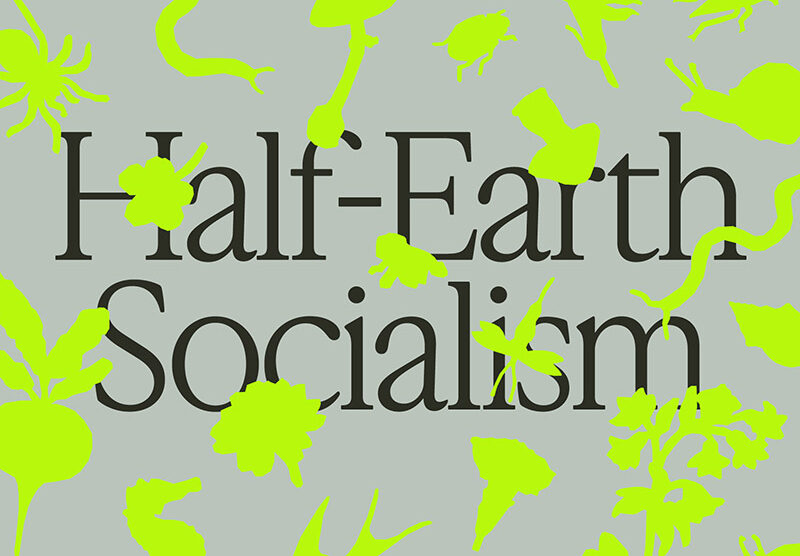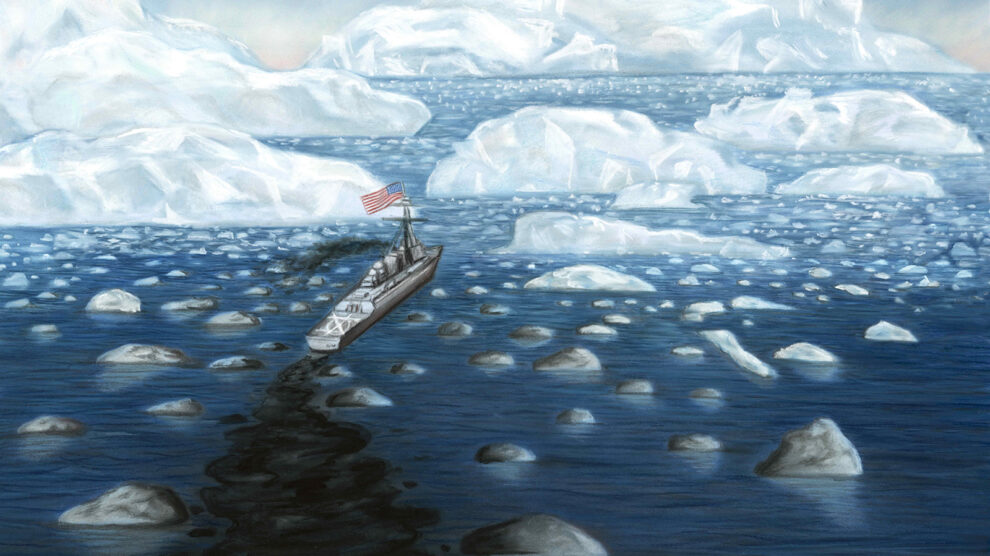No Wiser Than Before
An Introduction
By Erik Wallenberg & Ansar Fayyazuddin

“Beware of the man who works hard to learn something, learns it, and finds himself no wiser than before.” – Kurt Vonnegut, Cat’s Cradle
 The world is predominantly conceptualized as split between the subjects of history (humans) and the objects of history (everything else). The undifferentiated mass of everything else–identified as nature, or the environment–is treated as if it is simply for human use. Only in periods of crisis do we recognize that there are limits to what can be done to nature before the balance is tilted to a degree that things begin to go horribly wrong for humans as well. Against this reductive split, the world is in fact an ecological whole. Whatever conceptual divisions one makes, one cannot wish away our interdependence and the ultimate unity of the human and non-human worlds.
The world is predominantly conceptualized as split between the subjects of history (humans) and the objects of history (everything else). The undifferentiated mass of everything else–identified as nature, or the environment–is treated as if it is simply for human use. Only in periods of crisis do we recognize that there are limits to what can be done to nature before the balance is tilted to a degree that things begin to go horribly wrong for humans as well. Against this reductive split, the world is in fact an ecological whole. Whatever conceptual divisions one makes, one cannot wish away our interdependence and the ultimate unity of the human and non-human worlds.
We are living through an ecological disaster. Fueled by the drive for profit, the exploitation of both nature and human labor are defining features of our time. Ecosystems are collapsing under the assault of fossil fuel extraction, geological manipulation, and the systematic release of toxins into our water, air and earth. Islands are sinking as sea levels rise. Children are poisoned by lead in their water. Bee colonies are dying off as weather patterns change. And rapacious capitalist greed remains unabated.
The crisis of climate change is undeniable and requires urgent attention for anyone concerned with the fate of humanity and the world. However, when thought of in the narrowest terms, climate change is shorthand for the rise in global temperatures driven by the precipitous increase in heat trapping greenhouse gases. When the problem is formulated entirely in terms of physical data and timeless mechanism, it is shorn of its historical and social specificity and its provenance in the capitalist drive for profit and its reliance on fossil fuels. Without historical and social context, climate change appears simply as a problem of science, to be solved with technology.
From Barack Obama’s science advisor to the current Republican House Science Committee, the large-scale manipulation of the climate to mitigate global warming–geoengineering, for short–has gained a hearing in the halls of government.1 For their part, billionaire tycoons such as Bill Gates and Richard Branson champion their own role to drive geoengineering innovation. As several contributors to this collection point out, even the United Nations’ Intergovernmental Panel on Climate Change (IPCC) has legitimated geoengineering as a possible solution.
With this special issue of Science for the People, we aim to engage with this current of thought and interrogate the research and technology, the assumptions and costs, as well as the general focus on the technological and how that relates to the social, political, and economic questions that drive this crisis.
Geoengineering: A Fix or a Cover?
Clive Hamilton, author of Earthmasters: The Dawn of the Age of Geoengineering, divides geoengineering schemes into two broad categories. He identifies “Carbon dioxide removal technologies” that “aim to extract excess carbon from the atmosphere and store in somewhere less dangerous,” as a “kind of clean-up operation.” The second category he sees as “an attempt to mask one of the effects of dumping waste into the sky.” This is exemplified by “Solar radiation management technologies” that “seek to reduce the amount of sunlight reaching the planet” in order to reduce the amount of trapped energy in the atmosphere.2 He concludes that, “While advances in climate science ought to be teaching us to be more humble, advocates of schemes aimed at regulating sunlight or interfering in Earth-system processes seem to draw the opposite conclusion.”3
The first category—the “cleanup operation” school of geoengineering thought—enjoys near common sense status, particularly as more thoroughgoing political solutions to overhaul the energy sector appear too far off to make the needed difference. And yet, as reported last year in WIRED and The New Yorker, even the carbon capture methods that the IPCC mitigation strategies rely on, remain speculative. And if such negative emissions technologies do emerge, their implementation on the scale necessary guarantees massive disruptions to ecosystems and food markets. So what happens when the pragmatic option is itself unrealistic?
Hamilton’s second, more desperate category has become increasingly prominent. One speculative scientific paper touted by authors from both the political mainstream and on the radical left proposes a geoengineering project to save the Great Barrier Reef from a warming ocean.4 By spraying salt water into the air, the scientists suggest, clouds will form, reflecting more sun and lowering local temperatures just enough to prevent ocean warming. But even if this lowered local temperatures, it would need to be done in perpetuity as global temperatures would continue to rise all around it. Any glitch in the system of salt water spraying would send temperatures soaring and could be even more catastrophic, allowing no time for adaptation, migration, or evolution of coral species.
The original Science for the People ended publication in 1989, just as the modern consensus about anthropogenic climate change was beginning to emerge. In this collection of essays, contributors delve into the technical and political–as well as legal and ethical–challenges raised by the specter of geoengineering. Here, we step into today’s debates about the role of technology in resolving the climate crisis. But first, we look at 20th century experiments in weather modification–a useful corollary to today’s proposals to manipulate the climate–and some of Science for the People’s coverage and analysis at the time.
Weather Manipulation as Warfare
Hypothetical solutions advanced by today’s geoengineering enthusiasts date back to 1950 in New York City when, facing a water crisis, the city sought to fill its reservoirs in the Catskills. For a fee of $50,000, meteorologist Wallace E. Howell promised to create rain-on-demand by dumping dry ice and silver iodide into clouds over the Catskills. Within a week of implementation, so much rain had fallen over the Catskills that some reservoirs filled to overflowing.
The program continued all summer with rains refilling all of the cities reservoirs. “Resort owners and farmers alike,” writes historian David Stradling, “both now soaked by a summer of unusually heavy rains, wondered how it was that the city could have the legal right to make it rain outside the city itself. The city controlled the watersheds and the skies above them too.” And while the State Supreme Court ruled that the city could in fact make it rain in the Catskills, the question was left unresolved as the city discontinued its cloud seeding program later that year before the case could be appealed or heard by a higher court.5
Whether cloud seeding had an impact on the rains could not be determined with a single experiment. But what is clear is that lacking political power, upstate New Yorkers were deemed less important, sentenced to a summer of rain and floods that wiped out crops, washed out summer retreats, and cost the mountain region in jobs and general welfare amidst dreary days. The struggle for who gets to control natural resources remains with us today, but now in the form of geoengineering schemes. And all the questions raised by this case come back on a global scale.
More nefarious still was the US military’s role in weather manipulation over the skies of Vietnam and Laos. The first discussion in Science for the People of a program to manipulate the weather was in the July 1972 issue.6 In an article titled “Weather Warfare” we learn that the Chicago collective of Science for Vietnam put together a report on the militarization of the weather. Drawing on the Pentagon Papers, the collective found that the US military began attempting to modify the weather in Laos as early as 1967 in what has now become a series of infamous operations collectively known as Operation Popeye. A sub-operation, Operation Intermediary Compatriot, for example, attempted to flood the Ho Chi Minh Trail and wash out villages.7
In a March 1975 article “Selling the Rain,”8 Science for the People reported on weather modification in Vietnam carried out by the CIA in 1963. The article quotes a member of Nixon’s council on environmental quality: “As economic competition among disadvantaged nations heightens, it may be to a country’s advantage to insure a peaceful, natural environment for itself and a disturbed environment for its competitors…such a secret war need never be declared or known by the affected populations…The years of drought and storm could be attributed to unkindly nature.”9
Between 1967 and 1972 the Pentagon spent $21.3 million flying 2,602 missions over Vietnam and surrounding countries to see if they could “soften roads, cause landslides, and wash out river crossings.” The Pentagon determined that weather manipulation was a “valuable tactical weapon.”10
But it was not only rain that was being manipulated. Secret Pentagon hearings, later declassified, revealed that the military believed it was also able to clear fog, reduce hail, influence cloud formation, snow and lightning. The efficacy of these programs remains uncertain fifty years later.11 Their moral repugnancy, on the other hand, remains certain.
Modification of weather and climate is not politically neutral. It has military and profit driven origins, and has always raised the question of democracy. First, who gets to decide how weather is modified? Who is the rainmaker and who gets dumped on? And second, does the technology work, and can we even make that determination given all the factors that go into weather patterns? If we scale this up to the climate, how can we know the impacts we’re having on such a large, non-human scale?
Alternatives to Geoengineering
The task at hand appears to us to be the creation of healthy relationships for human and non-human interactions on this finite planet. Our debate should not be about whether technology is good or bad, or whether humans should or should not shape the environment; rather we must find a way to incorporate ecological complexity into a democratic system. When we neglect the historical and social context in favor of a narrow focus on technical aspects of a problem, the sources of the problem remain unaddressed.
The near eradication of tuberculosis in the late twentieth century is instructional. Richard Lewontin showed the irrelevance of identifying the disease’s bacterial agent in precipitating its decline. Lewontin recognized, of course, the necessity of the presence of the bacillus for the disease to occur, but showed that the decline in the disease was unrelated to attempts at eliminating the bacilli. Instead, the decline of tuberculosis coincided with the introduction of better nutrition, hygiene, and education. Thus, from the point of view of the eradication of the illness, the most successful public health measures improved the general wellbeing of people via social reforms.12
What might the tuberculosis example tell us about addressing climate change? One possible lesson is that we should introduce programs that help protect air and water quality, promote general well being of all species, and encourage practices like agroecology. Thus, free or cheap public transportation, restrictions on emissions of poisonous and greenhouse gases, elimination of dumping waste that contaminates our water, and other sensible protective measures would not only have far more predictable consequences but also a clear benefit for the entire ecosystem.
In a debate on geoengineering, physicist, ecologist, and environmentalist Vandana Shiva noted,
“Einstein warned us, you can’t solve problems with the same mindset that created them…The geoengineers don’t realize, sunshine is not a curse on the planet. The sun is not the problem, the problem is the mess of pollution we are creating. These shortcuts that are attempted from places of power, and I would add places of ignorance of the ecological web of life, are then creating the war solution. Because geoengineering becomes war on a planetary scale; with ignorance; and blind spots.”13
We’re faced with a pile of unknowns from those advocating and conducting geoengineering research. While time and money are spent researching technological fixes with unintended consequences, the solutions that we know will work–leaving fossil fuels in the ground, transitioning to sustainable forms of energy, increasing energy efficiencies, eliminating military spending, and engineering buildings and transport to cut out the waste–all of these solutions, which could be immediately implemented, are not funded because they do not fit into the current paradigm.
“In our progress-minded society,” Barry Commoner14 wrote in 1971,
“anyone who presumes to explain a serious problem is expected to offer to solve it as well… But none of us…can possibly blueprint a specific ‘plan’ for resolving the environmental crisis. To pretend otherwise is only to evade the real meaning of the environmental crisis: that the world is being carried to the brink of ecological disaster not by a singular fault, which some clever scheme can correct, but by the phalanx of powerful economic, political, and social forces.”15
It’s these forces we need to change. There is no shortcut or silver bullet or technological gimmick to building an alternative to capitalist catastrophe. Science for the People offered invaluable tools for that project a generation ago when they wrote: “If scientists want to help prevent socially destructive applications of science, they must forego acting in an ad hoc or purely moralistic fashion, and begin to respond collectively from the vantage point of a political and economic analysis of their work.”16 With this return to publishing, the new Science for the People aims to pick up where the original left off to create a space for discussion and debate about the science and politics of building a better world.
References
- https://www.theguardian.com/environment/2009/apr/08/geo-engineering-john-holdren; https://earther.com/republicans-decided-to-talk-about-a-dramatic-climate-so-1820266491.
- Clive Hamilton, Earthmasters: The Dawn of the Age of Climate Engineering (New Haven: Yale University Press, 2013) 1.
- Hamilton, Earthmasters, 116.
- Earth, Wind and Fire, special issue, Jacobin 26 (Summer 2017)
- David Stradling, Making Mountains: New York City and the Catskills (Seattle: University of Washington Press, 2008), 172-176; For a more thorough discussion of the domination of nature and it’s subjugation to market forces in the case of weather manipulation for profit, see Theodore Steinberg, Slide Mountain: Or, the Folly of Owning Nature (Berkeley: University of California Press, 1995), 106-134.
- http://science-for-the-people.org/wp-content/uploads/2015/07/SftPv4n4s.pdf
- “Weather Warfare,” Science for the People, Vol. 4, No. 4 (July, 1972), 9.
- http://science-for-the-people.org/wp-content/uploads/2015/07/SftPv7n2s.pdf
- Quoted in Mark Looney, “Selling the Rain: Weather Modification as a Weapon of Imperialism,” Science for the People, Vol. 7, No. 2 (March, 1975), 23. Gordon J. F. MacDonald makes a similar argument in “How to Wreck the Environment” in Nigel Calder, Ed., Unless Peace Comes: A Scientific Forecast of New Weapons (New York: The Viking Press, 1968), 203. Retired U.S, Navy Captain, Howard T. Orville, chair of the Congressional Advisory Committee on Weather Control, made a similar argument in 1954. See James R. Fleming, “Fixing the Weather and Climate: Military and Civilian Schemes for Cloud Seeding and Climate Engineering” in Lisa Rosner, Ed., The Technological Fix: How People Use Technology to Create and Solve Problems (New York: Routledge, 2004). The arrogance of being able to control and predict the weather down to the minute is echoed by MacDonald 15 years later.
- Looney, “Selling the Rain,” 24.
- Looney, “Selling the Rain,” 24.
- Richard Lewontin, Biology as Ideology: The Doctrine of DNA (New York: Harper Perennial, 1991).
- Democracy Now! “A Debate on Geoengineering: Vandana Shiva vs. Gwynne Dyer,” aired July 8, 2010, https://www.democracynow.org/2010/7/8/a_debate_on_geoengineering_vandana_shiva
- https://studsterkel.wfmt.com/blog/tag/barry-commoner/
- Commoner, The Closing Circle, 299.
- Bill Zimmerman, Len Radinsky, Mel Rothenberg, Bart Meyers, “Toward a Science for the People” 1972 in Sigrid Schmalzer, Daniel S. Chard, and Alyssa Botelho, eds., Science for the People: Documents From America’s Movement of Radical Scientists (Amherst: University of Massachusetts Press, 2018), 16.





